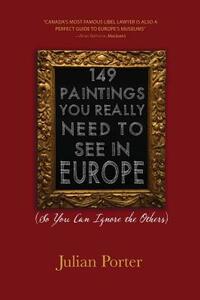Take a photo of a barcode or cover
1 review for:
149 Paintings You Really Need to See in Europe: (so You Can Ignore the Others)
Julian Porter
1 review for:
149 Paintings You Really Need to See in Europe: (so You Can Ignore the Others)
Julian Porter
Meh, this was OK, I guess. The writing style feels as though Porter / Grant recorded themselves talking about each painting or museum and then transcribed what they'd said rather than actually crafting sentences-- lots of odd constructions, incomplete sentences, and exclamations, which in some cases actually do describe the emotional flavor of a particular work, but often just seem facile childish, and unnecessary.
I used it during a trip to DC and a visit to the National Gallery, which comprises Chapter 12. The works selected were, overall, strange to me. There was a beautiful Sargent, the lone DaVinci in North America, a wonderful van Gogh self-portrait mixed in with incomprehensibly obscure pieces that seemed, at best, vaguely interesting. Part of the problem seems to be that the National Gallery has a far less interesting collection than other DC museums (the Portrait Gallery and the Smithsonian Museum of Art come to mind), but in that case, why not highlight the actual highlights and leave the rest? Some of the paintings profiled seemed interesting only because their subjects lived soap opera lives, not because the art was significant.
Overall, this book seems to have an unnecessarily outsized erection for art that may be seen in New York, which, while certainly a rich scene, is hardly the only place in North America with notable collections. The gimmick of "149 paintings" (replicated here after the success of the authors' 149 Paintings You Really Need to See in Europe) seems to push the text toward a glut of offerings from NYC museums and an unfocused smattering from the others.
I found it particularly galling to learn that the National Gallery's lackluster collection noted above, merited an entire chapter, while the Carnegie Museum of Art in Pittsburgh PA isn't even included, despite hosting the longest-running art exhibition in the world and owning some of the most seminal pieces of art from the 1800s forward. This book also neglects such important collections as those at the Milwaukee Museum of Art (with it's near-comprehensive Georgia O'Keeffes) and Mineapolis' Walker Art Museum and Sculpture Garden. It seems odd to me to focus on anything obscure whatsoever in a restricted format like this (only 149 items), rather than, say, listing the single best work to see at a variety of small museums. Overall, the gimmick does a disservice to everyone involved: the art lover and museum goer, the artists, the museums themselves, and the authors, who look foolish.
Verdict: this book may be of use if you're visiting the vast array of museums in NY in a limited amount of time, but you will miss quite a lot if you're relying on it as a guide for anything else.
I used it during a trip to DC and a visit to the National Gallery, which comprises Chapter 12. The works selected were, overall, strange to me. There was a beautiful Sargent, the lone DaVinci in North America, a wonderful van Gogh self-portrait mixed in with incomprehensibly obscure pieces that seemed, at best, vaguely interesting. Part of the problem seems to be that the National Gallery has a far less interesting collection than other DC museums (the Portrait Gallery and the Smithsonian Museum of Art come to mind), but in that case, why not highlight the actual highlights and leave the rest? Some of the paintings profiled seemed interesting only because their subjects lived soap opera lives, not because the art was significant.
Overall, this book seems to have an unnecessarily outsized erection for art that may be seen in New York, which, while certainly a rich scene, is hardly the only place in North America with notable collections. The gimmick of "149 paintings" (replicated here after the success of the authors' 149 Paintings You Really Need to See in Europe) seems to push the text toward a glut of offerings from NYC museums and an unfocused smattering from the others.
I found it particularly galling to learn that the National Gallery's lackluster collection noted above, merited an entire chapter, while the Carnegie Museum of Art in Pittsburgh PA isn't even included, despite hosting the longest-running art exhibition in the world and owning some of the most seminal pieces of art from the 1800s forward. This book also neglects such important collections as those at the Milwaukee Museum of Art (with it's near-comprehensive Georgia O'Keeffes) and Mineapolis' Walker Art Museum and Sculpture Garden. It seems odd to me to focus on anything obscure whatsoever in a restricted format like this (only 149 items), rather than, say, listing the single best work to see at a variety of small museums. Overall, the gimmick does a disservice to everyone involved: the art lover and museum goer, the artists, the museums themselves, and the authors, who look foolish.
Verdict: this book may be of use if you're visiting the vast array of museums in NY in a limited amount of time, but you will miss quite a lot if you're relying on it as a guide for anything else.

